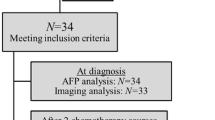Abstract
Background
Children with hepatoblastoma routinely undergo repetitive surveillance imaging, with CT scans for several years after therapy, increasing the risk of radiation-induced cancer.
Objective
The purpose of this study was to determine the utility of surveillance CT scans compared to serum alpha-fetoprotein (AFP) levels for the detection of hepatoblastoma relapse.
Materials and methods
This was a retrospective study of all children diagnosed with AFP-positive hepatoblastoma from 2001 to 2011 at a single institution.
Results
Twenty-six children with hepatoblastoma were identified, with a mean age at diagnosis of 2 years 4 months (range 3 months to 11 years). Mean AFP level at diagnosis was 132,732 ng/ml (range 172.8–572,613 ng/ml). Five of the 26 children had hepatoblastoma relapse. A total of 105 imaging exams were performed following completion of therapy; 88 (84%) CT, 8 (8%) MRI, 5 (5%) US and 4 (4%) FDG PET/CT exams. A total of 288 alpha-fetoprotein levels were drawn, with a mean of 11 per child. The AFP level was elevated in all recurrences and no relapses were detected by imaging before AFP elevation. Two false-positive AFP levels and 15 false-positive imaging exams were detected. AFP elevation was found to be significantly more specific than PET/CT and CT imaging at detecting relapse.
Conclusion
We recommend using serial serum AFP levels as the preferred method of surveillance in children with AFP-positive hepatoblastoma, reserving imaging for the early postoperative period, for children at high risk of relapse, and for determination of the anatomical site of clinically suspected recurrence. Given the small size of this preliminary study, validation in a larger patient population is warranted.
Similar content being viewed by others
References
Honeyman JN, La Quaglia MP (2012) Malignant liver tumors. Semin Pediatr Surg 21:245–254
Meyers RL (2007) Tumors of the liver in children. Surg Oncol 16:195–203
De Ioris M, Brugieres L, Zimmermann A et al (2008) Hepatoblastoma with a low serum alpha-fetoprotein level at diagnosis: the SIOPEL group experience. Eur J Cancer 44:545–550
Semraro M, Branchereau S, Maibach R et al (2013) Relapses in hepatoblastoma patients: clinical characteristics and outcome — experience of the International Childhood Liver Tumour Strategy Group (SIOPEL). Eur J Cancer 49:915–922
Armenian SH, Landier W, Hudson MM et al (2013) Children’s Oncology Group’s 2013 blueprint for research: survivorship and outcomes. Pediatr Blood Cancer 60:1063–1068
Malogolowkin MH, Katzenstein HM, Krailo M et al (2008) Redefining the role of doxorubicin for the treatment of children with hepatoblastoma. J Clin Oncol 26:2379–2383
Perilongo G, Maibach R, Shafford E et al (2009) Cisplatin versus cisplatin plus doxorubicin for standard-risk hepatoblastoma. N Engl J Med 361:1662–1670
McCarville MB, Kao SC (2006) Imaging recommendations for malignant liver neoplasms in children. Pediatr Blood Cancer 46:2–7
Pearce MS, Salotti JA, Little MP et al (2012) Radiation exposure from CT scans in childhood and subsequent risk of leukaemia and brain tumours: a retrospective cohort study. Lancet 380:499–505
Malogolowkin M, Katzenstein HM, Krailo M et al (2006) Intensified platinum therapy is an ineffective strategy for improving outcome in pediatric patients with advanced hepatoblastoma. J Clin Oncol 24:2879‐2884
Rathore N, Eissa HM, Margolin JF et al (2012) Pediatric Hodgkin lymphoma: are we over-scanning our patients? Pediatr Hematol Oncol 29:415–423
Ahmed BA, Connolly BL, Shroff P et al (2010) Cumulative effective doses from radiologic procedures for pediatric oncology patients. Pediatrics 126:e851–e858
Gelfand MJ, Lemen LC (2007) PET/CT and SPECT/CT dosimetry in children: the challenge to the pediatric imager. Semin Nucl Med 37:391–398
Smith MA, Seibel NL, Altekruse SF et al (2010) Outcomes for children and adolescents with cancer: challenges for the twenty-first century. J Clin Oncol 28:2625–2634
Pierce DA, Preston DL (2000) Radiation-related cancer risks at low doses among atomic bomb survivors. Radiat Res 154:178–186
Brenner DJ, Hall EJ (2007) Computed tomography — an increasing source of radiation exposure. N Engl J Med 357:2277–2284
Kan JH, Hwang M, Lowas SR et al (2011) Impact of pelvic CT on staging, surveillance, and survival of pediatric patients with Wilms tumor and hepatoblastoma. AJR Am J Roentgenol 196:W515–W518
Goske MJ, Applegate KE, Boylan J et al (2008) The ‘Image Gently’ campaign: increasing CT radiation dose awareness through a national education and awareness program. Pediatr Radiol 38:265–269
Voss SD, Chen L, Constine LS et al (2012) Surveillance computed tomography imaging and detection of relapse in intermediate- and advanced-stage pediatric Hodgkin’s lymphoma: a report from the Children’s Oncology Group. J Clin Oncol 30:2635–2640
Chong AL, Grant RM, Ahmed BA et al (2010) Imaging in pediatric patients: time to think again about surveillance. Pediatr Blood Cancer 55:407–413
Trobaugh-Lotrario AD, Tomlinson GE, Finegold MJ et al (2009) Small cell undifferentiated variant of hepatoblastoma: adverse clinical and molecular features similar to rhabdoid tumors. Pediatr Blood Cancer 52:328–334
Cruz RJ Jr, Ranganathan S, Mazariegos G et al (2013) Analysis of national and single-center incidence and survival after liver transplantation for hepatoblastoma: new trends and future opportunities. Surgery 153:150–159
Conflicts of interest
None
Author information
Authors and Affiliations
Corresponding author
Rights and permissions
About this article
Cite this article
Rojas, Y., Guillerman, R.P., Zhang, W. et al. Relapse surveillance in AFP-positive hepatoblastoma: re-evaluating the role of imaging. Pediatr Radiol 44, 1275–1280 (2014). https://doi.org/10.1007/s00247-014-3000-6
Received:
Revised:
Accepted:
Published:
Issue Date:
DOI: https://doi.org/10.1007/s00247-014-3000-6




